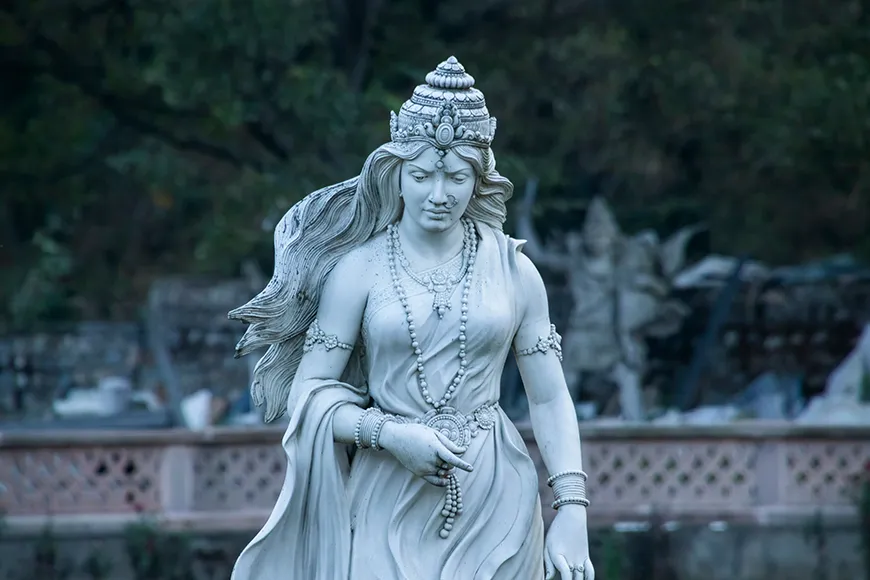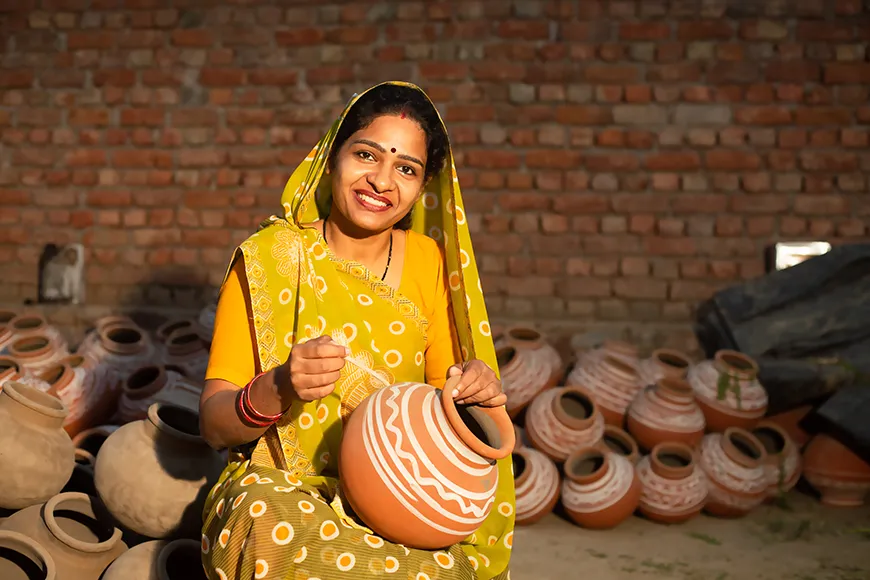Spirituality•February 12, 2023
The Role of Shakti in Hinduism
Shakti is one of the most fundamental concepts of the Hindu Tradition. It represents the divine feminine, and is typically associated with the mother goddess. According to the Hindu tradition, Shakti is responsible for the universe's creation, maintenance, and destruction.
Read on to learn about the origins and evolution of Shakti as a creative and spiritual force and its contemporary influence on popular culture and media.
The Role of Shakti in Hinduism: Understanding the Divine Feminine

Shakti is one of the most important concepts in the Hindu religion.
Origins and Evolution
The concept of Shakti has been a fundamental part of the Hindu tradition for thousands of years. Archeologists have found the earliest mentions of it tracing back to the Indus Valley civilization, where various ancient artifacts depict the worship of the Mother Goddess. Shakti is also mentioned in Rig Veda, one of the oldest Hindu scriptures, describing her as the cosmic energy that permeates the universe.¹
However, worshiping Shakti as a distinct form of the divine feminine did not become prevalent until later in Hindu history. More specifically, the widespread worship of her as a primary deity emerged in the medieval period with the rise of Shakta sects.
The Role of Shakti as a Creative Force
Based on the Hindu tradition, the goddess Shakti is generally associated with creative energy and is responsible for the universe’s creation and destruction. Shakti also represents various goddesses who embody a broad set of elements and roles.
Hindu mythology often portrays her as a powerful, dynamic force that drives the universe forward. One of the most significant ways Shakti manifests as a creative force is as the mother goddess, an essential aspect of the Hindu religion, believed to represent the nurturing and life-giving aspects of the divine feminine.
The mother goddess is often depicted as a powerful warrior who wields weapons to protect and defend her devotees. She is associated with birth, death, and rebirth cycles. Her nurturing and protective qualities make her a symbol of compassion, love, and strength, representing the ideals of motherhood.
People worship the goddess for her power but also for creative energy, as is reflected in various cultural and artistic practices such as the elaborate and beautiful Rangoli designs. These designs consist of patterns made on the ground using a combination of colored sand, rice, and flower petals. Many Rangoli designs feature images of worshiped goddesses like Lakshmi or Durga. People consider these designs as a way to honor and welcome the divine feminine into their homes.
Similarly, the celebration of Navratri is a festival dedicated to the worship of the goddess Durga in her various forms. The festival is celebrated over nine nights and involves fasting, puja (worship), and other rituals to honor the goddess.
The Role of Shakti as a Spiritual Force
The worship of Shakti is essential to many Hindu practices and rituals. As a spiritual force, Shakti is associated with kundalini energy, which, according to Hindu teachings, lies dormant at the base of the spine and can be awakened through various spiritual practices. Yagna, on the other hand, is a way to worship that involves praying to the goddess and giving her offerings in a sacred fire.
Another example is the practice of tantra, which is closely related to the worship of Shakti. Tantra is a spiritual practice that uses the divine power of the feminine to achieve transformation and self-development. The practice involves meditation, breathwork, and visualization to awaken kundalini energy and channel it toward spiritual growth.
Influence on Culture and Media

Shakti is one of the most important concepts in the Hindu religion.
Shakti has significantly impacted popular media and culture, especially in India, where many people embrace the divine feminine as a symbol of female empowerment.
The Bollywood film industry produces many films depicting the power and strength of feminine energy. One famous example is “Mother India,” about a woman’s struggle to raise her children against all odds, which is praised for portraying the mother goddess as a symbol of resilience and strength.
Some feminists criticize the association between Shakti and women because it leads to society labeling them as either good or bad, with no gray area in between. One of the key issues with this association is a societal expectation for women to adhere to rigid gender roles. Women may feel the need to conform to certain ideals of femininity, such as being nurturing, caring, and selfless, to embody the qualities of Shakti. This becomes particularly problematic for women who do not necessarily conform to these rigid definitions of womanhood, as they might be ostracized or marginalized by society.
However, others see Shakti as a symbol of female strength and resistance to the patriarchy. Regardless, the symbolic value of Shakti plays a vital role in Indian culture. It has ignited a conversation about the critical roles women have in society and the problems they face.
Conclusion
Shakti plays an integral part in Hinduism as a dynamic and powerful force. The influence of Shakti exists ritualistically, spiritually, and within popular culture and media.
By understanding Shakti's role in Hinduism, we can appreciate the symbolic value of a very powerful concept. If you are interested in learning more about similar concepts and their impact on society, consider checking out our Graduate School of Psychology or email an Admission Advisor to learn more about our programs.
References
- Kinsley, D. (1988). Hindu goddesses: Visions of the divine feminine in the Hindu religious tradition (Vol. 12). Univ of California Press.
- Garcia-Sesnich, J. N., Flores, M. G., Ríos, M. H., & Aravena, J. G. (2017). Longitudinal and immediate effect of Kundalini Yoga on salivary levels of cortisol and activity of alpha-amylase and its effect on perceived stress. International journal of yoga, 10(2), 73.
- Eyre, H. A., Siddarth, P., Acevedo, B., Van Dyk, K., Paholpak, P., Ercoli, L., ... & Lavretsky, H. (2017). A randomized controlled trial of Kundalini yoga in mild cognitive impairment. International psychogeriatrics, 29(4), 557-567.
- Mirauda, D. C., Cruzat-Mandich, C., Moore, C., Ugarte, M. L., & Díaz-Castrillón, F. (2017). Kundalini yoga in women with anorexia nervosa and bulimia nervosa: A qualitative research. Revista mexicana de trastornos alimentarios, 8(1), 82-94.
People also ask
What are other names for Shakti?
Shakti is a term commonly used in Hinduism to refer to divine feminine energy. However, other names for Shakti are used in Hindu mythology and tradition.
- Kali - refers to Shakti's fierce and powerful aspects; associated with death and destruction.
- Durga - refers to the warrior aspect of Shakti, linked with strength and protection.
- Parvati - refers to Shakti's gentle and nurturing aspects; associated with fertility and motherhood.
- Tripura Sundari - translates to “the most beautiful woman in the three worlds” and is often used to refer to the beauty and grace of Shakti.
Is there a symbol for Shakti?
There are several symbols associated with Shakti in Hinduism, including:
- Trishula - a three-pronged spear or trident that is often associated with Shiva, the male counterpart of Shakti. The Trishula also symbolizes Shakti’s power to destroy evil and negative forces.
- Lotus - symbolizes purity and spiritual enlightenment; often associated with the divine feminine. The lotus flower is also a symbol of the creative power of Shakti.
- Om - a sacred sound representing the essence of the universe or cosmic energy, often associated with Shakti’s power to create and sustain life.
- Sri Yantra - a geometric symbol representing the union of masculine and feminine energies; often associated with the goddess Tripura Sundari, considered the ultimate embodiment of Shakti.
These symbols are often used in Hindu art and religious practices to represent the power and presence of Shakti.
How can I practice Shakti?
In Hinduism, Shakti is practiced through various spiritual activities such as yoga, tantra, and meditation. According to Hindu traditions, one can awaken and channel the energy of Shakti using these practices, leading to profound spiritual experiences and insights.
For example, in Kundali yoga, practitioners believe that a dormant energy called Kundalini lies at the base of the spine, and awakening and challenging this energy through the chakras can lead to spiritual experiences and insights.
In order to awaken the Kundalini energy and channel it through the chakras, Kundalini yoga leads practitioners through a series of physical postures, breathing techniques, and meditation practices. As the energy rises through the chakras, it activates and balances them, leading to physical, mental, and emotional experiences.
Kundalini awakening can produce physical sensations such as tingling, heat, and vibrations in the body, as well as increased awareness and intuition. Emotionally, it can invoke feelings of joy, love, and peace. Research shows that Kundalini yoga could lower stress levels, improve one’s cognition and body positivity, and lead to more self-acceptance.²⁻⁴
It is recommended that Kundalini yoga be practiced with the help of a yoga instructor.
Learn More
Interested in learning more about the programs at Meridian?
Contact An Advisor »Attend an Info Session »



Submitting
Stay Inspired
Receive exclusive content on personal and professional transformation via email with expert insights in psychology, leadership, education, and more.
We don’t email frequently and you can always unsubscribe. By continuing, you are agreeing to Meridian’s Privacy Policy.